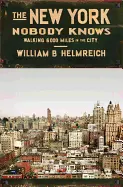
The New York Nobody Knows - by William Helmreich
ISBN: 0691169705Date read: 2019-10-20
How strongly I recommend it: 4/10
(See my list of 360+ books, for more.)
Go to the Amazon page for details and reviews.
Fascinating if you want to get to know NYC better. Author walked every single block of every borough in New York City. 6000 miles. Talked with everyone he could along the way. Shares his experience and insights here.
my notes
A city is an outdoor museum.
You cannot merely walk through a city to know it. You have to stop long enough to absorb what’s going on around you.
And the only way to do that is to immerse yourself in it - spending as much time as possible in the streets; hanging out where others gather; attending meetings, concerts, sporting events, and the like; in short, doing what those who live there do.
Because I wanted their answers to be spontaneous and relaxed, I would say something like: “How come you’re dressed like this?” or “Is this neighborhood safe?” or “Do you find this job boring?”
People don’t pay close attention to what you say as long as you say something. I would ask someone if I could use their bathroom because I was going to a wedding.
The energy emanates from the immigrants and the gentrifiers.
The immigrants, with their often incredible drive and ambitions, which are, in turn, fueled by the dreams they have of changing the trajectory of their own lives for the better.
The ambivalence felt by outer borough residents toward Manhattan has greatly diminished.
Groups who have been hostile to one another in the homeland have dramatically different relationships here.
The conflicts back home seem irrelevant in the American context.
Many see their move to America as an opportunity to develop friendships that they had once considered unthinkable.
New Yorkers think of their communities as if they were miniature countries.
An attempt to manage the realities of living in a large anonymous place through creating a space that they can identify with and truly call home.
A neighborhood’s attractiveness: that sense of community is all about friendliness, warmth, and pride in where they live.
More than three million people having arrived in NYC since the 1960s.
The immigrants’ energy and ambition to remake their lives and to achieve their dreams have had a major impact on the city, giving it a certain dynamism that can be felt by anyone who walks the streets, especially the teeming neighborhoods in which they have settled.
This has the unintended but real consequence of decreasing the opportunities for Puerto Ricans and African Americans who have been mired in poverty here, sometimes for generations,
The immigrants tend to live among their own kind. This is partly because of the comfort level they feel when they do so and partly because of the fact that certain groups have come in waves over a short period of time.
Gentrifiers and the poor with whom they live are neighbors but rarely friends, other than hello or a quick superficial exchange of pleasantries.
Each has its own group with whom they have much more in common.
And there is a perception that the gentrifiers are snobby and look down on them.
Block associations are an integral part of city life and they play a major role in the stability of communities.
Neighborhoods often look and feel completely different in the evening than they do in the daytime, in different seasons, and on weekdays as opposed to weekends. The people, the activities, the look, the safety factor, everything, can change.
Chess has gained significantly in popularity, especially among blacks.
Dominoes is ubiquitous in Hispanic communities.
It’s in the parks, with their peaceful atmosphere, that the warmth and openness of the city comes into clearer view. Everything seems to be occurring in slow motion in contrast to the speed at which the city normally moves.